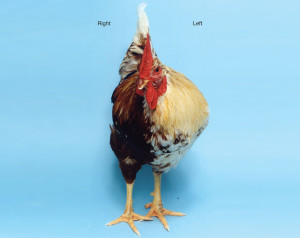Chicken cells determine sex by themselves
Unusual embryonic development in chickens can result in strange mixed-sex birds.
In vertebrates, it has been thought that the sex of somatic cells?general body cells excluding sperm and ova?is determined by sex hormones, such as testosterone and estrogen, which are secreted from gonads (male or female sex organs). This was thought to apply to all vertebrates, including birds. However, a study of androgynous, or mixed-sex, birds published in Nature on 11 March 2010, shows that birds’ somatic cells are not influenced by sex hormones, but determine their sex on their own.
The researchers studied gynandromorphic chickens?a rare form of chicken which has both male and female characteristics. The chickens appeared female on one side and male on the other. The female side was brown and had a small wattle and leg spur, which was characteristic of female chickens, while the male side was white and had a large wattle, leg spur and a greater muscle mass.
The researchers examined somatic cells from each side of the birds to analyze the sex of the individual cells. They found that the male side was composed of male cells and the female side was composed of female cells, and the cells had no chromosomal abnormalities which might account for the birds’ strange characteristics. This confirms that the gynandromorphic birds have a mixture of both male and female cells which have determined their sex independently.
So how is sex determined in other vertebrates, including humans? The early embryo of other vertebrates does not specialize to become male or female until the sex-determining gene promotes the development of either male or female gonads. The gonads then produce sex hormones which trigger all cells to become male or female. That is why, if we transplant a portion of the male pre-gonad embryo to the same place in a female embryo, the cells from the male embryo become female because they are influenced by the female hormone. However, this is not the case in chickens. The transplanted portion continues to develop as its original sex.
These results show that the somatic cells of chickens determine their own sex identity, and do not depend on sex hormones. This unusual nature results in the appearance of these strange gynandromorphic birds.
Assistant Professor Ryusuke Niwa of the University of Tsukuba says “Developmental biologists had generally believed that all vertebrates share the same mechanism for sex determination. This study defies the common wisdom of the vertebrate sex determination theory and strongly indicates that birds follow a different developmental pattern from mammals.”
Further reading:
Somatic sex identity is cell autonomous in the chicken,?Nature?464, 237-242








Let me tell You a sad story ! There are no comments yet, but You can be first one to comment this article.
Write a comment